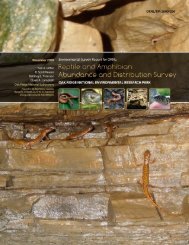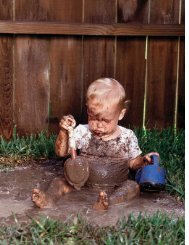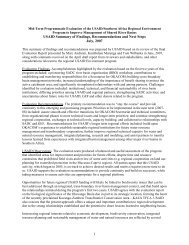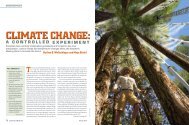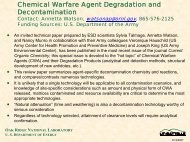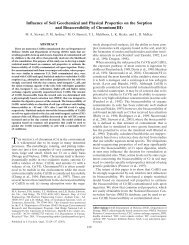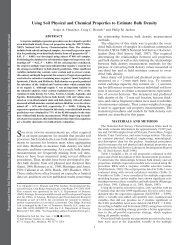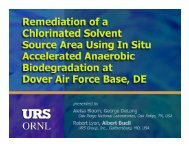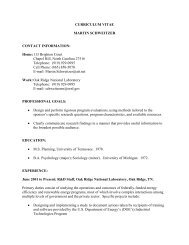ORNL Pond; Past, Present, and Future
ORNL Pond; Past, Present, and Future
ORNL Pond; Past, Present, and Future
- No tags were found...
You also want an ePaper? Increase the reach of your titles
YUMPU automatically turns print PDFs into web optimized ePapers that Google loves.
Transition of the <strong>Pond</strong>• Although a fixture on campus, <strong>ORNL</strong> Swan <strong>Pond</strong> wasnot integrated into the l<strong>and</strong>scape.• As it was managed, pond invited use by large numbersof Canada geese.• Fish fauna of pond was dominated by non-nativespecies.
Transition of the <strong>Pond</strong>Initially itlooked like afarm pond.August 1965
<strong>Pond</strong> was managed for swans.Exotic mute swans controlledhow pond was managed.
<strong>Pond</strong> was managed for swans.Access to the pond wascontrolled, <strong>and</strong> vegetationwas limited to trees.
<strong>Pond</strong> was managed for swans.Chain link fence was used tokeep swans on pond. Theywere fed grains, excessvegetables, etc., with supplyusually exceeding dem<strong>and</strong>.Excess food attracted otherbirds, including largenumbers of Canada geese<strong>and</strong> domesticated ducks.
<strong>Pond</strong> was managed for swans.Excess food <strong>and</strong> bird excrement kept water enriched <strong>and</strong>supported large numbers of non-native fish species (e.g.,goldfish, fathead minnows) <strong>and</strong> invasive aquatic plants.
<strong>Pond</strong> was managed for swans.Grass carp were added to pond in 1970s to control submergedvegetation, but they left the water turbid most of the time.
Transition of the <strong>Pond</strong>• <strong>ORNL</strong> swan pond was targeted for“make-over” as part of the East Campusrevitalization in 2004.• Primary goal was to blend it into thesurrounding area, making it a focus forpedestrians <strong>and</strong> cafeteria users.• Secondary goals were to make it a morenatural system reflective of area fauna<strong>and</strong> flora <strong>and</strong> help deal with nuisancegeese.
Transition began with removing swans• Because waterfowl arefederally managed,permits <strong>and</strong> approvalswere needed.• A suitable relocation sitewas needed.• Some local “champions”had to be consulted <strong>and</strong>convinced.
Swans were moved to a local pond inOctober 2004.
Transition included physicalchanges to pond <strong>and</strong> area.• During construction of visitor center <strong>and</strong>cafeteria:– Chain link fence removed: Dec 2004;– Water feature <strong>and</strong> berm added: June 2005;– Feeding pier, dead trees, <strong>and</strong> nesting isl<strong>and</strong>removed: July 2005; <strong>and</strong>– New sidewalk <strong>and</strong> boardwalk over pondadded: July – Sept 2005.
More physical changesLater, benches, river rock,<strong>and</strong> turtle platforms wereadded.
Transition continued with changesin fauna <strong>and</strong> flora.• Grass carp were removed to facilitate theestablishment of emergent <strong>and</strong> floatingvegetation in January <strong>and</strong> December2005.• Many large goldfish were also wereremoved. Some goldfish remain.
Removal of carp: Phase I
Removal of carp: Phase II
Removal of carp: Phase III
Removal of carp: Phase IV
Removal of carp: Mostly
Transition continued with changesin fauna <strong>and</strong> flora.• Sunfish added February 2006.• Largemouth bass added February 2007.• Native turtles, spotted gar, <strong>and</strong> morebass added April 2007.Redear sunfish Largemouth bass Bluegill
EasternpaintedturtleSpotted garLargemouth
Transition continued with changesin fauna <strong>and</strong> flora.• A management <strong>and</strong> l<strong>and</strong>scape plan forthe pond was developed to guidetransition.• Wetl<strong>and</strong> plants were added to make thepond appear “more natural” <strong>and</strong> toprovide improved habitat.• Shoreline plants were added to providevisual appeal.
Shoreline floral changes• Invasive shrubs <strong>and</strong> trees sprayed <strong>and</strong>removed: March 2005 <strong>and</strong> April 2008• Non-native grasses sprayed: June 2005,April <strong>and</strong> June 2006, <strong>and</strong> April 2008• Trees <strong>and</strong> shrubs planted on east <strong>and</strong>north shores: Sept. 2005• Flowers planted on south shore: June2005, June 2006, May 2007, June-July2008
East Shore PlantingsBeautyberryOak leaf hydrangea
South Shore PlantingsSideoatsgramaBee balmPurpleGrayheaded coneflower
North Shore PlantingsBlazingstarRed maple
West Shore PlantingsButtonbushSycamore <strong>and</strong>black willowSwamp mallow
Emergent <strong>and</strong> floating plantswere added.• Emergent <strong>and</strong> floating plants wereprimarily located inside wire cages toreduce herbivore pressure.• Supplemental plantings of emergentplants were also made outside of cages.• Plants were obtained from nurseries, aswell as transplanted from Oak RidgeReservation wetl<strong>and</strong>s.
Planting July 2007
Emergent plantsSpike rushesCardinal flower
Emergent plantsSweet flagBlue flag iris
Emergent plantsArrowheadPickerel weed
Emergent plantsSedges <strong>and</strong> rushes
Floating plantsAmerican lotusWater lily
Floating plantsNon-native water lilyNative water lily
Transition progressAppearance: September 2004
Transition progressDuring construction: September 2005
Transition progressPlantings without cages: October 2006
Transition progressInitial cage plantings: July 2007
Transition progressPlants beginning to exp<strong>and</strong>: August 2007
End of first seasonof growth:September 2007Transition progress
Transition progressStatus: May 2008
Status:August 2008Transition progress
Algae bloom spring 2007Emergent <strong>and</strong> aquatic vegetationshould limit future blooms
Wildlife residentsNorthernwatersnakeEasternpaintedturtle
Wildlife visitorsBeltedkingfisherGreategretGreatblueheronKilldeer
Transition will continue.In summer 2008 moreaquatic <strong>and</strong> shorelineplanting was done, <strong>and</strong> apurple martin house wasadded.<strong>Future</strong> plans call foradditional shorelineplantings <strong>and</strong> bird houses,as well as efforts tocontrol non-native fish.




